Summary
April 18, 1864. Marmaduke attacked and destroyed a Union supply train returning to Camden at Poison Spring.
The Route
▷ We previously visited White Oak Lake State Park and finished at the boat ramp, which is our starting point.
▷ Upper White Oak Lake Boat Ramp, Ouachita County ARContinue on Arkansas 387 about 1.6 miles uphill to the stop sign at Arkansas 57. Highway 387 is scenic as it winds around the lake and then climbs to higher ground in the piney woods of the Western Gulf Coastal Plain in southern Arkansas.
▷ Arkansas 387 becomes Arkansas 76 at Arkansas 57, Ouachita County ARContinue straight onto Arkansas 76, driving 2.3 miles.
▷ Poison Spring Fire Tower, Ouachita County ARThe Poison Spring Fire Tower (on the left, north side of the highway, across from a tall white cylindrical water tower). Proceed another 1.5 miles.
▷ Poison Spring State Park, Ouachita County ARPoison Spring State Park (on the left, north side). Continue eastward on Arkansas 76 for 2.8 miles.
▷ Arkansas 76 at Arkansas 24, Ouachita County ARTurn right (eastward) on Highway 24 and follow it for 6.3 miles.
▷ Ark 24 at Ark 278 and Ark 278B/Washington St, Camden ARArkansas 24 at Arkansas 278.
▷ This brings us to our next point of interest, Camden.
Google Maps
Show my location on map
At the popup, you must allow your web brower (not us) to know your location.
Your location should update every 5 seconds.
This brings us to our next point of interest, Camden.
Fire Tower Near Poison Spring
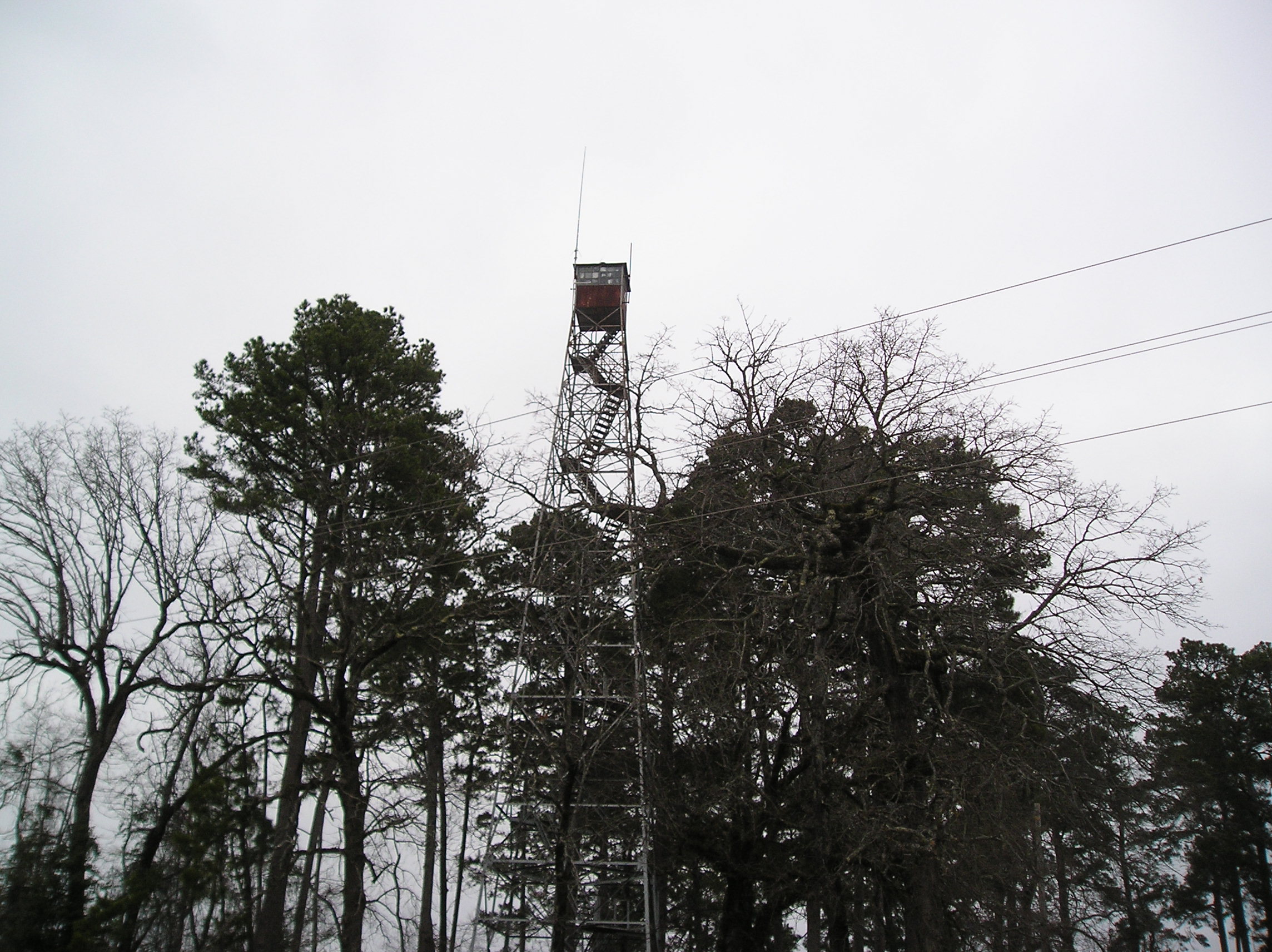
The fire tower standing along Highway 76 is a landmark and is known as the Poison Spring Tower. Believed to have been built by the CCC in 1937-38 and 100' tall, it was staffed until 1985 but is now one of a decreasing number of fire towers remaining in the woodlands of Arkansas.
Photo by Peggy Lloyd
The Reason for the Battle at Poison Spring
The Union Army reached Camden on April 15, 1864, in search of supplies, and they were soon disappointed at how little they found to feed thousands of hungry soldiers and their equally hungry horses and mules. On the 17th of April, General Steele sent out an expedition to forage for supplies of corn reputed to be in the White Oak Creek area about eighteen miles from Camden. The force included over 600 hundred soldiers under the command of Col. James M. Williams, along with 198 wagons and four cannons. They foraged the area gathering remaining supplies of corn and other plunder from farms and plantations before regrouping at White Oak Creek. An additional force of five hundred men, including cavalry and infantry and two pieces of artillery, joined Col. Williams' force the next day. The combined Union forces of some 1,100 found themselves facing 3,600 Confederate soldiers under the command of Brig. General John Sappington Marmaduke and Brig. General Samuel B. Maxey who were blocking the road to Camden. Fighting ensued in a series of attacks with the Union troops retreating after the third attack. The Confederate cavalry pursued retreating Union forces for two and a half miles before breaking off pursuit and turning their attention to the Union wounded and prisoners of war. The Battle at Poison Spring became notorious for the killing and mutilation of wounded and captured Black troops in this engagement after the battle had ceased.
The First Kansas Colored and the Losses at Poison Spring
Union losses were 301 men killed, wounded or missing. The majority of those killed or wounded were colored troops from the First Kansas Colored with 117 dead and 65 wounded. The First Kansas Colored had been made up of former slaves and free persons of color from Arkansas and Missouri. Some Union officers had at first doubted the potential of Black troops, but the First Kansas Colored had performed well at the Battle of Honey Springs in Indian Territory in July 1863. Honey Springs was the largest Civil War battle in Indian Territory, now Oklahoma, and involved Indian troops on both sides as well as the First Kansas Colored on the Union side. It was a Union victory. Col. Tandy Walker's Choctaw Confederate troops were at Poison Spring and were perhaps eager to repay that earlier loss. Confederate losses at Poison Spring are not known exactly but were probably somewhere between 114 and 145.
The Monuments from Different Eras at Poison Spring
Numerous monuments, markers and signage from different eras are at the Poison Spring State Park. The oldest is the stone monument placed on the site by the Camden UDC in 1929. It is followed by a stone monument from the 1936 Centennial of Arkansas statehood. A metal marker dates from the 1964 Centennial of the Civil War from 1961-65. A more recent sign notes that Poison Spring is one of the Camden Expedition National Historic Landmarks, sites of national consequence. Other markers under the pavilion give details on the forces and the battle. There are picnic tables for visitors and a short hiking trail. Re-enactments take place every two years with Confederate and Union re-enactors from the region and re-enactors of the First Kansas Colored troops from nearby Camden.
Poison Spring Marker (1929)
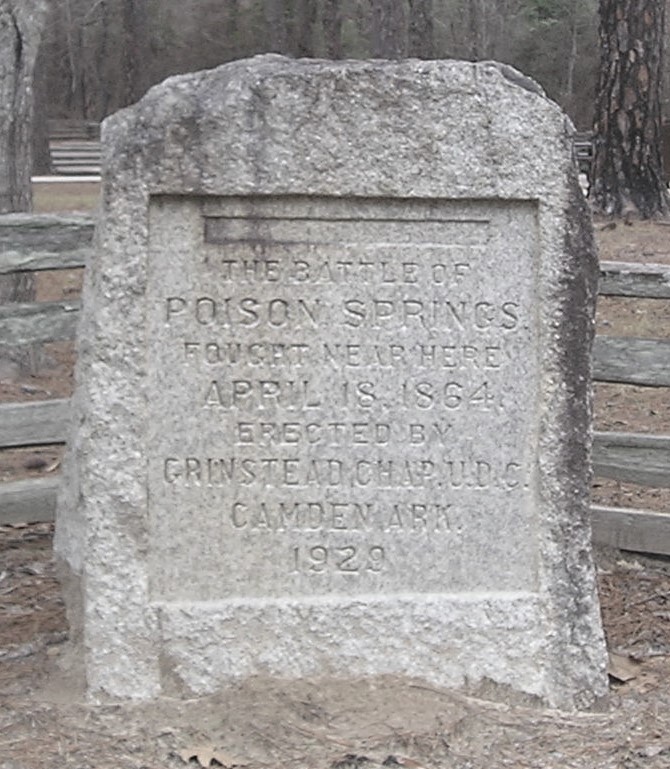
The Battle of Poison Springs fought near here on April 18, 1864
Erected by Grinstead Chap.U.D.C.
Camden, Ark.
1929
Numerous monuments, markers and signage from different eras are at the Poison Spring State Park. The oldest is the stone monument placed on the site by the Camden UDC in 1929.
Photo by Peggy Lloyd
Poison Spring Marker (1936)
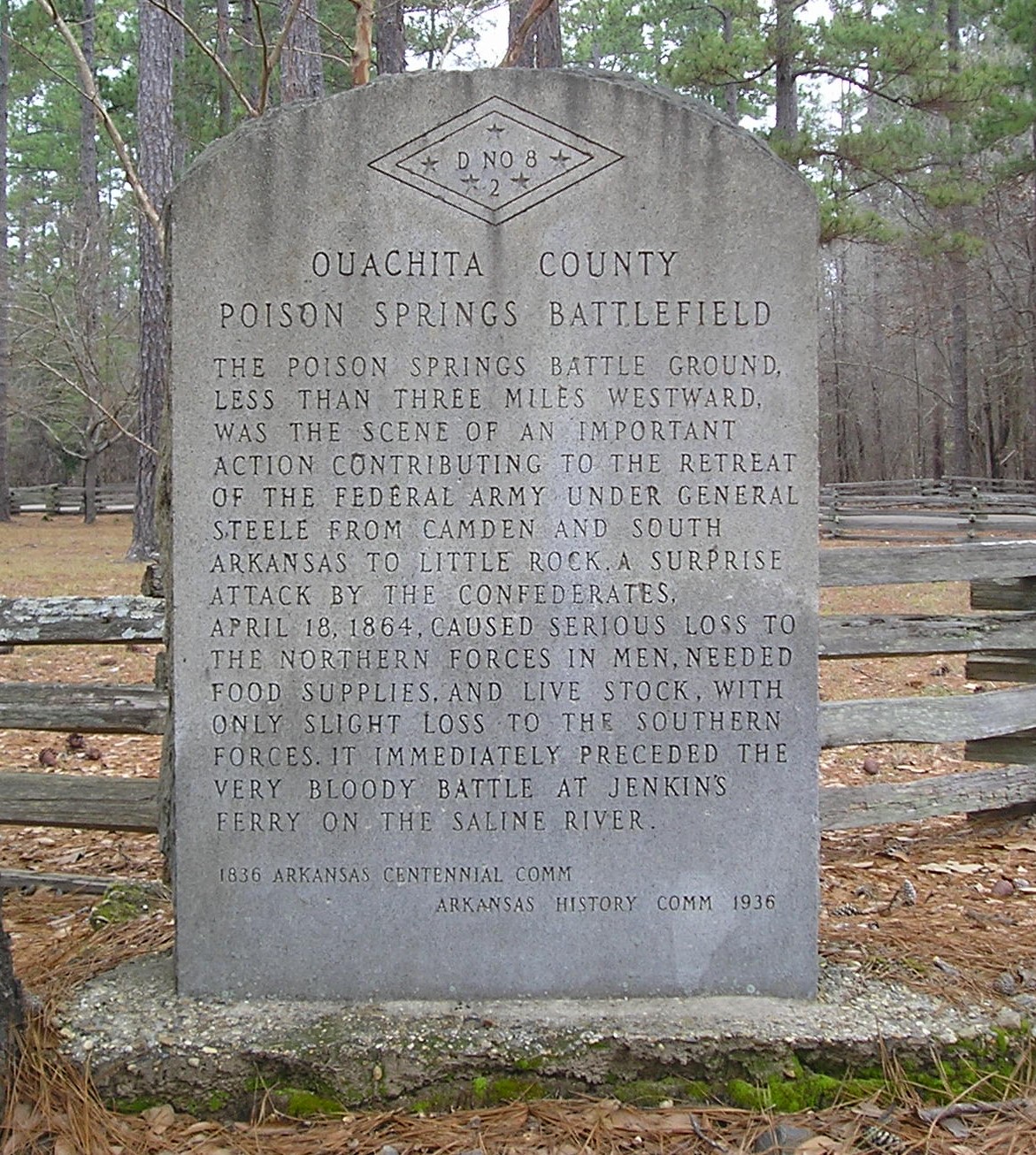
It is followed by a stone monument from the 1936 Centennial of Arkansas statehood.
The Poison Springs Battle Ground, less than three miles westward, was the scene of an important action contributing to the retreat of the Federal Army under General Steele from Camden and south Arkansas to Little Rock. A surprise attack by the Confederates April 18, 1864, caused serious loss to the Northern forces in men, needed food supplies, and live stock, with only slight loss to the Southern forces. It immediately preceded the very bloody battle at Jenkins Ferry on the Saline River.
1836 Arkansas Centennial Comm
Arkansas History Commission 1936
Photo by Peggy Lloyd
Engagement at Poison Springs Marker

A metal marker dates from the 1964 Centennial of the Civil War from 1961-65.
Here on April 18, 1864 a Union forage train of 200 wagons escorted by 1170 men was attacked and captured by Confederate troops commanded by Generals John S. Marmaduke and Samuel B. Maxey. The wagons were loaded with corn for the Union army of General Frederick Steele encamped at Camden. Loss of these supplies helped to hasten Steele's retreat to his base in Little Rock. The Union loss at Poison Springs was 301 men killed, wounded and mission. Confederate casualties totaled 114 men.
Erected by the Arkansas Civil War Centennial Commission - 1964
Photo by Peggy Lloyd
Sign on National Historic Landmarks
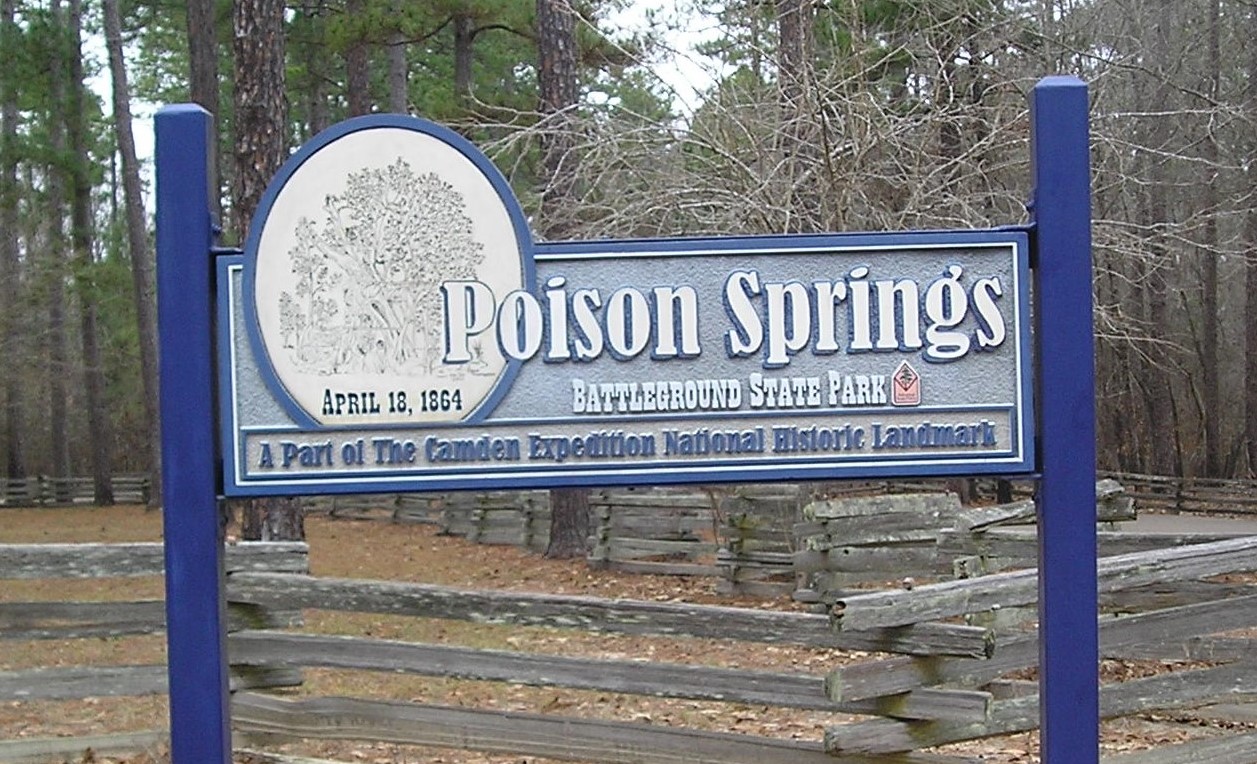
A more recent sign notes that Poison Spring is one of the Camden Expedition National Historic Landmarks, sites of national consequence.
Photo by Peggy Lloyd
Signage Under the Pavilion on Order of Battle
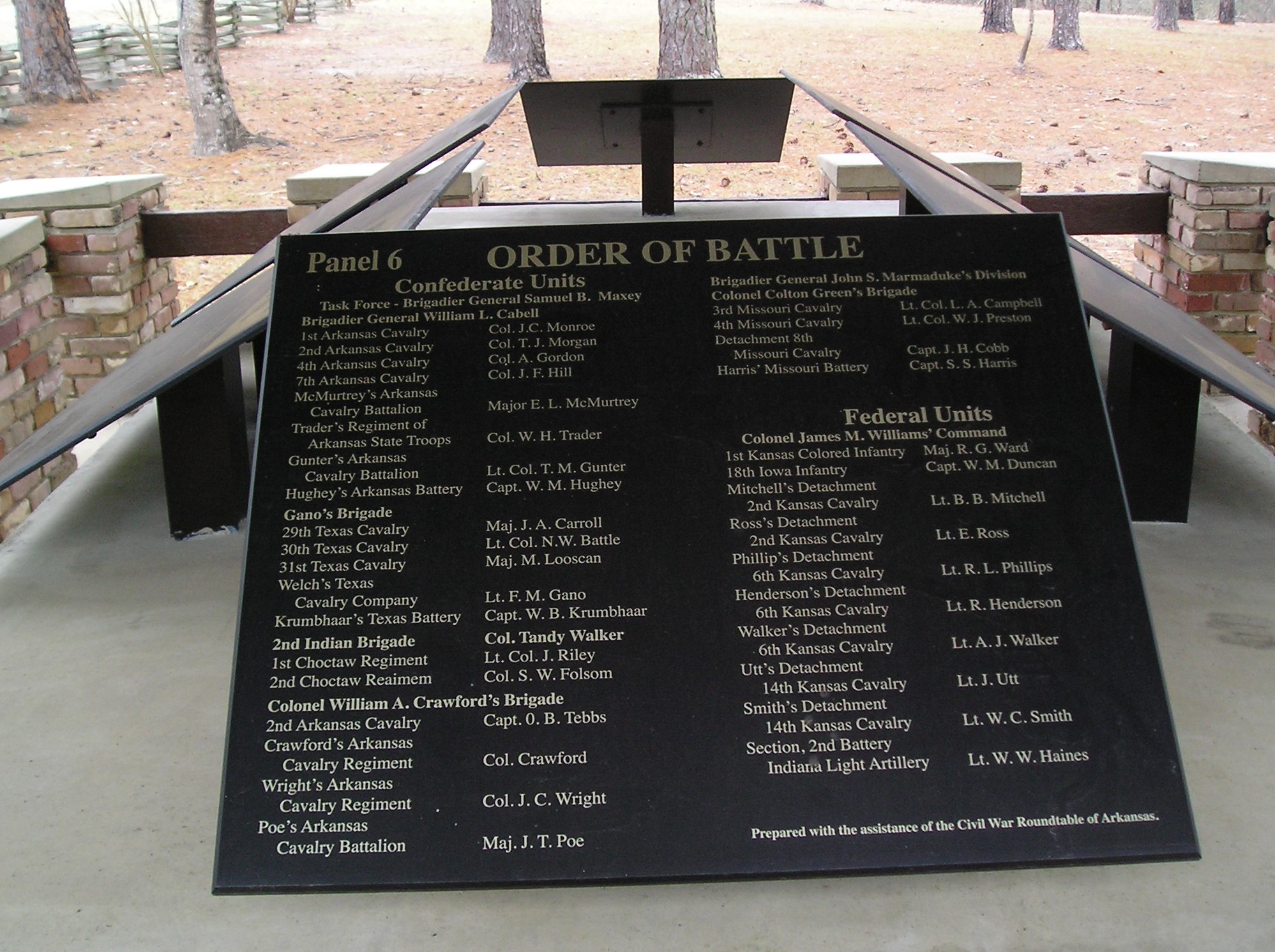
Other markers under the pavilion give details on the forces and the battle. There are picnic tables for visitors and a short hiking trail.
Panel 6 - Order of Battle
Confederate Units
Task Force - Brigadier General Samuel B. Maxey
1st Arkansas Cavalry - Col. J.C. Monroe
2nd Arkansas Cavalry - Col. T.J. Morgan
4th Arkansas Cavalry - Col. A. Gordon
7th Arkansas Cavalry - Col. J.F. Hill
McMurtrey's Arkansas Cavalry Battalion - Major E.L. McMurtrey
Trader's Regiment of Arkansas State Troops - Col. W.H. Trader
Gunter's Arkansas Cavalry Battalion - Lt. Col. T.M. Gunter
Hughey's Arkansas Battery - Capt. W.M. Hughey
Gano's Brigade
29th Texas Cavalry - Maj. J.A. Carrol
30th Texas Cavalry - Lt. Col. N.W. Battle
31st Texas Cavalry - Maj. M. Looscan
Welch's Texas Cavalry Company - Lt. F.M. Gano
Krumbhaar's Texas Battery - Capt. W.B. Krumbhaar
2nd Indian Brigade - Col. Tandy Walker
1st Choctaw Regiment - Lt. Col. J. Riley
Colonel William A. Crawford's Brigade
2nd Arkansas Cavalry - Col. O.B. Tebbs
Crawford's Arkansas Cavalry Regiment - Col. Crawford
Wright's Arkansas Cavalry Regiment - Col. J.C. Wright
Poe's Arkansas Cavalry Battalion - Maj. J.T. Poe
Brigadier General John S. Marmaduke's Division
Colonel Colton Green's Brigade
3rd Missouri Cavalry - Lt. Col. L.A. Campbell
4th Missouri Cavalry - Lt. Col. W.J. Preston
Detachment 8th Missouri Cavalry - Capt. J.H. Cobb
Harris' Missouri Battery - Capt. S.S. Harris
Federal Units
Colonel James M. Williams' Command
1st Kansas Colored Infantry - Maj. R.G. Ward
18th Iowa Infantry - Capt. W.M. Duncan
Mitchell's Detachment 2nd Kansas Cavalry - Lt. B.B. Mitchell
Ross's Detachment 2nd Kansas Cavalry - Lt. E. Ross
Phillips' Detachment 6th Kansas Cavalry - Lt. R.L. Phillips
Henderson's Detachment 6th Kansas Cavalry - Lt. R. Henderson
Walker's Detachment 6th Kansas Cavalry - Lt. A.J. Walker
Utt's Detachment 14th Kansas Cavalry - Lt. J. Utt
Smith's Detachment 14th Kansas Cavalry - Lt. W.C. Smith
Section 2nd Battery Indiana Light Artillery - Lt. W.W. Haines
Prepared with the assistance of the Civil War Roundtable of Arkansas.
Photo by Peggy Lloyd
Re-enactments
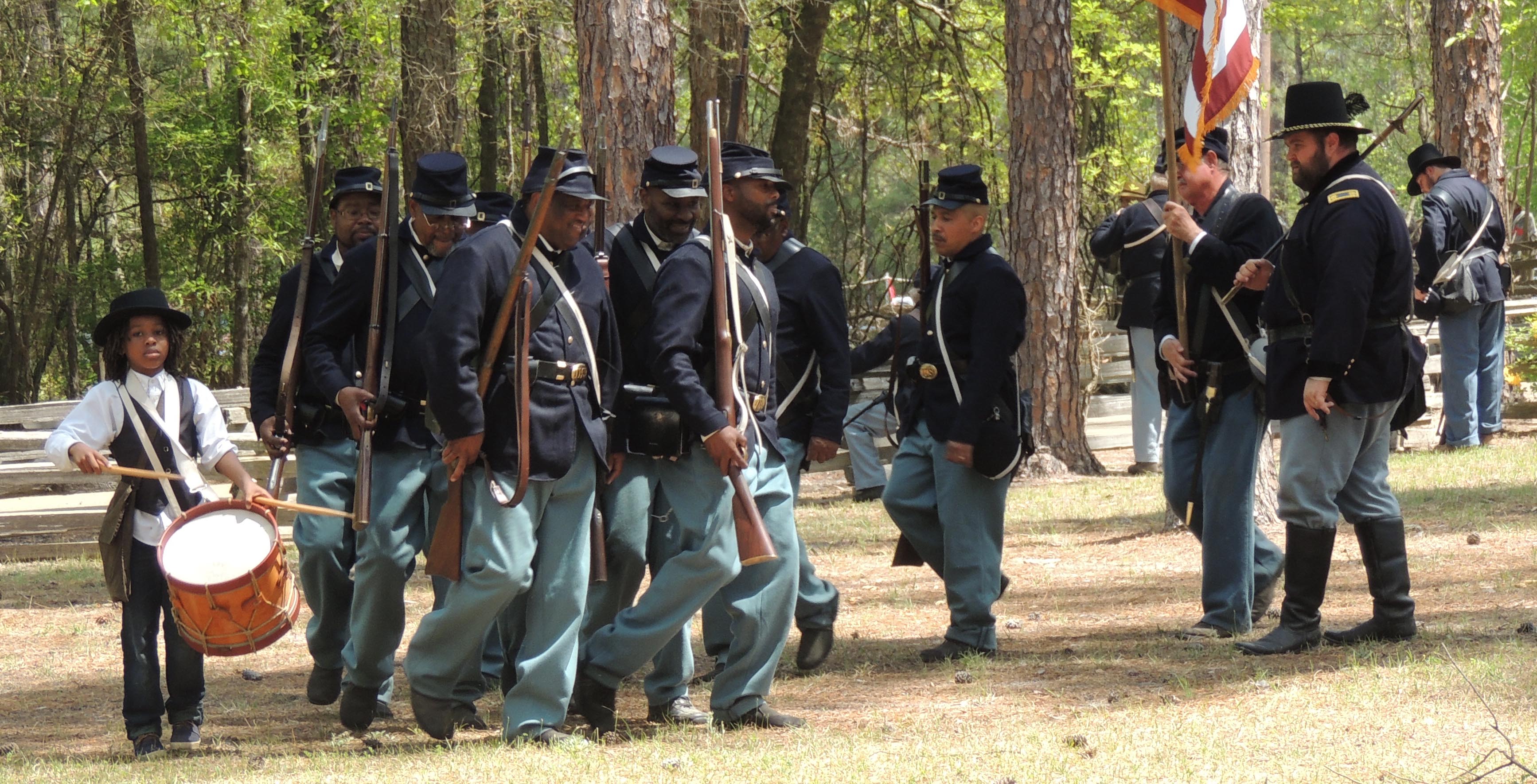
Re-enactments take place every two years with Confederate and Union re-enactors from the region and re-enactors of the First Kansas Colored troops from nearby Camden.
Photo by Paul Oller of Hope, AR
Up Next
This brings us to our next point of interest, Camden.


